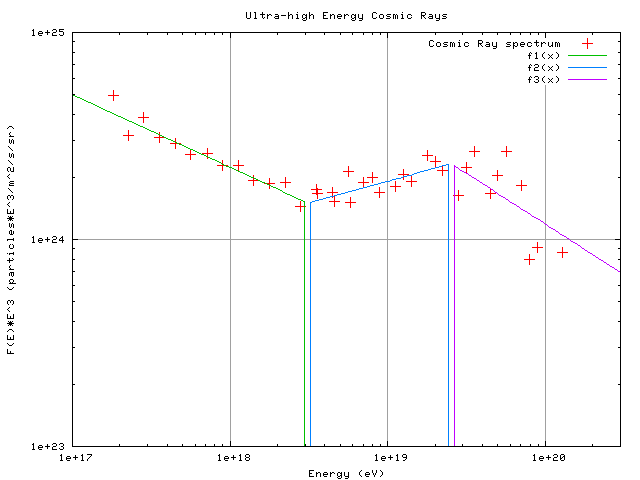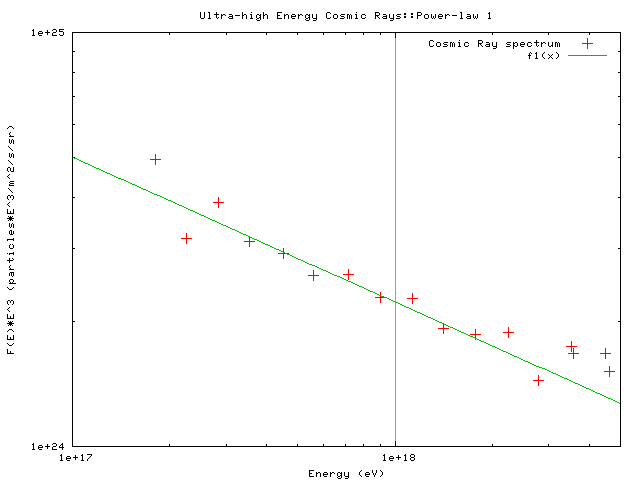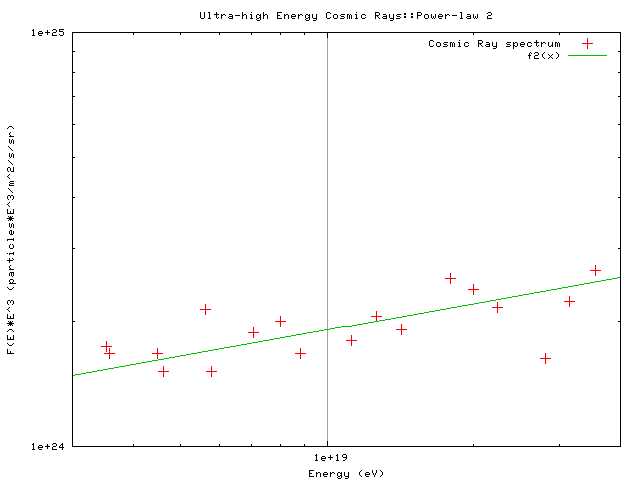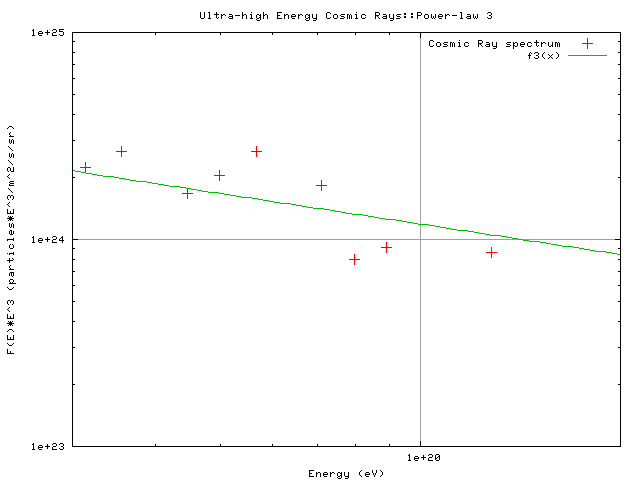Aaron Koga
Physics 305
6 Feb 2007
Physics 305
6 Feb 2007
1. Introduction

FIG1: High Energy Cosmic Ray Spectrum.

FIG2: High energy cosmic rays corresponding to power-law 1.

FIG3: High energy cosmic rays corresponding to power-law 2.

FIG4: High energy cosmic rays corresponding to power-law 3.
Cosmic rays are
particles, often hydrogen and helium nuclei, that originate somewhere
outside of earth. Ultra High Energy Cosmic Rays (UHECR) are
cosmic rays with extremely high energies of almost 50J.
Measurements of the differential flux of particles from a detector in
Utah, plotted in FIG1, show that theses UHECR obey three
power-laws.
Power-law 1: (1)
(1)
Power-law 2: (2)
(2)
Power-law 3: (3)
(3)
 (1)
(1)Power-law 2:
 (2)
(2)Power-law 3:
 (3)
(3)Each of these power-laws, which are
determined by fitting the data, gives the differential flux (in units
of m-2
s-1 sr-1 eV-1) as a function of
energy, E. Each power-law describing a different range of E is
plotted in FIG2-FIG4.
2. C Program
A C Program was written to numerically integrate the three power-laws for UHECR so that the total number of particles arriving at a detector could be calculated. The program is shown in the appendix. The simple program contains a function f(), which has the information to calculate the differential flux F(E) for each power-law. Trapez(), Simpson(), and Analytic() use f() to calculate the integral using the trapezoidal approximation, Simpson's approximation, and the analytic result respectively. The program outputs a file showing the results from the integration using these three methods. The integrals are performed using various lower limits (E=1017 eV, 1018 eV, 1019 eV, and 1020 eV). The final number for the integral is given in units of particle*m-2 s-1 sr-1 .3. Results
Trapezoidal
Approximation (particles/year)
Simpson's
Approximation (particles/year)
Analytic
Result (particles/year)
lower
limit E = 1017 eV
1.81(106)
1.55(106)
6.54(105)
lower
limit E = 1018 eV
9.13(103)
6.09(103)
2.98(103)
lower
limit E = 1019 eV
1.35(102)
1.58(102)
3.11(101)
lower
limit E = 1020 eV
1.64
1.10
1.46(10-1)
TABLE1: Results from the C Program's
output
The C Program was used to calculate the total number
of particles arriving at a square detector 10 km on a side in one year
for a solid angle acceptance of 1 sr. The output from the C
Program, which was given in particle*m-2
s-1 sr-1 , was multiplied by 3.076e15 to find
the particles/year arriving at the detector. These numbers are
shown in TABLE1. dE was set in the
C Program for the different power-laws by trial and error. A
simple C Program was used where the number of intervals (and thus dE=(Emin-Emax)/intervals)
used in the Trapezoidal and Simpson approximations were varied from
1-5000 for each power-law. The value for dE was set by choosing
the result for the integral of F(E) using the Trapezoidal/Simpson
approximation that was closest to the known analytical result.4. Conclusions
As seen in TABLE1,
the Trapezoidal and Simpson Methods do not do a good job of
approximating the function. The approximations overestimate the
function by factors ranging from ~2 to ~10. However, this over
estimation is not surprising. Because the function being
integrated (F(E)) goes as the negative power of E, the function "falls"
faster than either its linear approximation if the trapezoidal method
or its parabolic approximation in simpson's method. Because the
actual function falls faster than its approximations, the integral is
overestimated. It seems that because of the overestimation of the
Trapezoidal and Simpson Methods the approximations are useful only to
get a rough idea of the integral of F(E).
[1] P. W. Gorham, http://www.phys.hawaii.edu/~gorham/P305/UHECR.html.
"Cosmic Rays." http://en.wikipedia.org/wiki/Cosmic_ray.
Castelvecchi, Davide. "Let it Rain." Symmetry. http://www.symmetrymagazine.org/cms/?pid=1000063.
5.
References
[1] P. W. Gorham, http://www.phys.hawaii.edu/~gorham/P305/UHECR.html.
"Cosmic Rays." http://en.wikipedia.org/wiki/Cosmic_ray.
Castelvecchi, Davide. "Let it Rain." Symmetry. http://www.symmetrymagazine.org/cms/?pid=1000063.